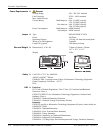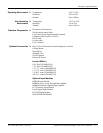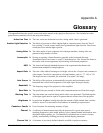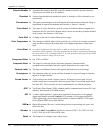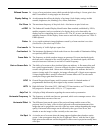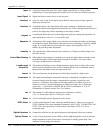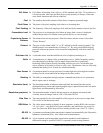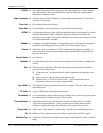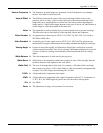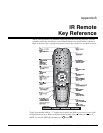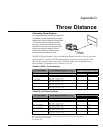
Appendix A: Glossary
A-6 Christie DS+60/DW30/Matrix 3000 User’s Manual 013-100149-02 Rev. 1 (01/07)
The output from certain video tape players and video equipment. S-Video separates
sync and luminance from color information, typically producing a higher quality
display than composite video.
The horizontal or vertical frequency at which images are generated. Also known as
scan rate or refresh rate.
One horizontal line on the display.
The horizontal or vertical frequency at which images are generated.
A video output format of some video tape and disk players (used primarily in France).
SECAM (Sequential Couleur á Mémoire) signals are similar in resolution and
frequency to PAL signals. The primary difference between the two standards is in the
way color information is encoded.
A slidebar is a graphical display of an adjustable setting. The numerical setting often
represents a percentage but can be a specific unit such as degrees Kelvin.
The device, such as a computer or VCR, connected to the projector for display. A
source may have numerous corresponding channels defined and recognized by the
projector. See Input.
See Channel.
A signal selector that can be connected to a projector for the purpose of adding more
sources.
This term refers to the part of the video signal that is used to stabilize the picture.
Sync can occur in three forms:
1) "Composite sync": the horizontal and vertical components are together on one
cable.
2) "Sync-on-green": the sync is part of the green video.
3) "Separate sync" or "H.SYNC and V.SYNC": the horizontal and vertical
components of the sync are on two separate cables.
The duration of each sync pulse generated by a computer. The sync width is part of
the blanking time.
A type of RGB video with digital characteristics.
A wire connecting a single video source to a display device, such as a projector, must
be terminated by a resistance (usually 75Ω for video).
The distance between the front feet of the projector and the screen. Also called
"Projector-to-Screen Distance”. Always use the correct Christie throw distance
formula to calculate the proper throw distance (±5%) required for your lens.
Throw ratio = throw distance / screen width. Typically used to differentiate lenses.
Balance of red-to-green necessary for realistic representation of NTSC signals.
The ability of a projector to synchronize to inputs with frequencies within a specified
range.
S-Video
f
Scan Fre
q
uenc
y
f
Scan Line
f
Scan Rate
f
SECAM
f
Slideba
r
f
Source
f
Source Setu
p
f
Switche
r
f
S
y
nc f
S
y
nc Width f
TTL Video
f
Terminated
f
Throw Distance
f
Throw Ratio
f
Tint
f
Variable Scan
f



